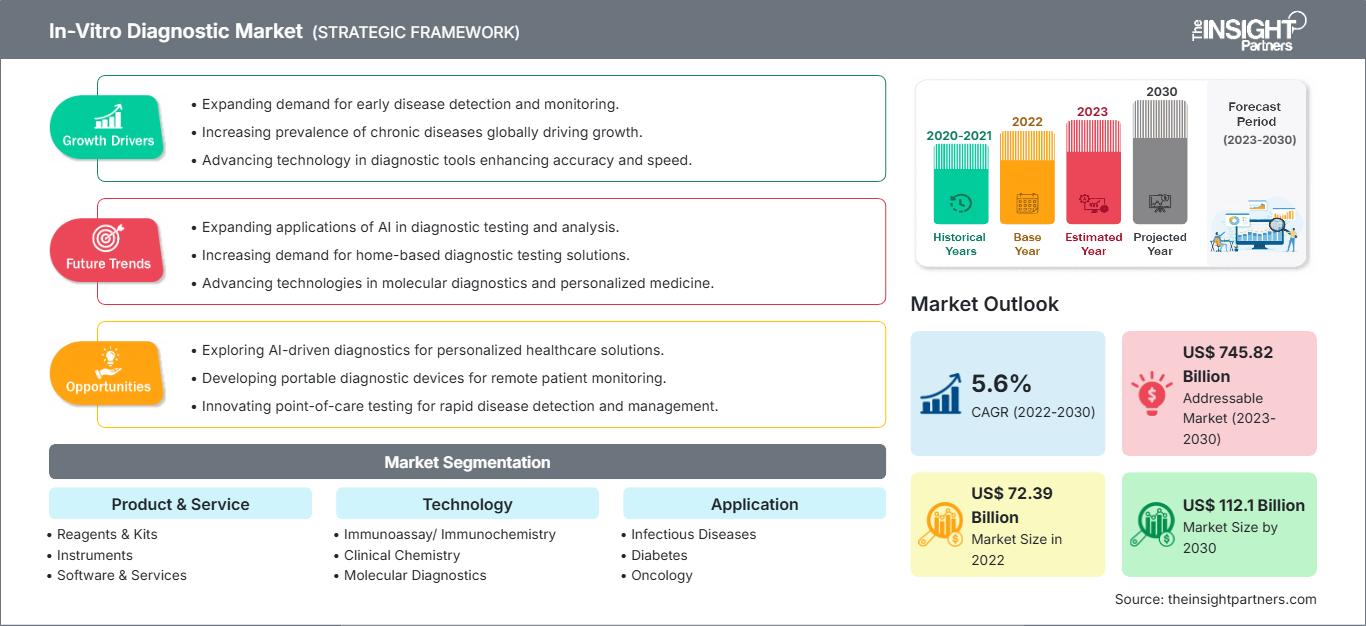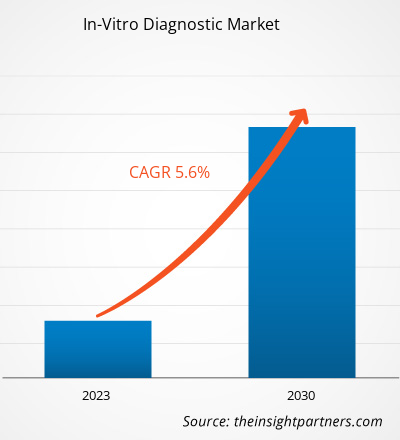[調査レポート] 体外診断市場規模は2022年に723億9,380万米ドルと評価され、2030年には1121億351万米ドルに達すると予測されています。市場は2022年から2030年にかけて5.6%のCAGRで成長すると予測されています。
市場分析とアナリストの見解:
体外診断には、人体から採取した尿、血液、組織などの生物学的サンプルを分析するために使用される臨床検査と医療機器が含まれます。これらの検査は、さまざまな病状の監視と診断に重要な役割を果たしています。慢性疾患の増加、技術の進歩、高齢化人口の増加は、体外診断市場の成長を牽引する注目すべき要因です。分子診断の進歩により、世界中の研究グループや医療従事者が、個人の遺伝子構成に基づいた個別化治療計画を改善するための取り組みが促進されています。インフラの発展と健康意識の高まりによる発展途上地域の成長機会も、2022~2030年の体外診断市場の成長予測と関連しています。
成長ドライバー:
CDCのデータによると、冠動脈疾患(CAD)は成人の死亡原因で最も一般的なものです。2021年には約375,476人がCADで亡くなりました。世界保健機関(WHO)の2022年全国糖尿病統計報告書で発表された推定によると、世界中で約4億2,200万人が糖尿病を患っており、その大半は低所得国と中所得国に住んでいます。さらに、毎年150万人が糖尿病に直接関連して亡くなっています。過体重、遺伝的疾患、高齢化、運動不足などの生活習慣が、糖尿病の有病率を押し上げています。 Cancer Research UKの報告書に掲載された推計によると、2020年には世界中で約1,810万人の新規がん症例が報告され、2040年までにその数は2,800万人に増加すると予想されています。そのため、心血管疾患、がん、糖尿病、呼吸器疾患などの感染症や慢性疾患の罹患率の上昇が、体外診断市場の成長を牽引しています。
IVDは、臨床、検査、外来診療の現場で使用され、特に疾患の検出を支援し、適切な治療プロトコルの選択を支援することを目的としています。IVD技術とデジタルヘルスソリューションの統合は、世界中で注目を集めています。データ分析、人工知能、遠隔モニタリングは診断検査の価値を高め、患者管理と転帰の改善につながります。デジタルヘルスソリューションと統合されたIVD技術は、臨床意思決定支援システムに組み込むことができます。WHOも認めているように、デジタルヘルスソリューションは疾患の検出に役立つ可能性があります。人工知能ヘルスボットなどの新興ソリューションは、患者ケアの機会を提供し、高コストや時間要件などの課題に対処する可能性があります。ゲノム検査に基づく診断において、ディープラーニングは特定のサンプルの画像からがん細胞を識別し、その種類を判定し、腫瘍にどのような変異が生じる可能性があるかを予測することができます。体外診断における人工知能(AI/ML)は、医療機器開発に革命をもたらしています。これらの最新の診断システムは、デジタル画像解析に基づく診断を容易にし、医療における意思決定を向上させます。スマート診断は、人工知能を活用することで、ラボベースの診断よりも優れた性能を、わずかなコストで実現する、非常に拡張性の高い体外診断(IVD)ソリューションです。さらに、この種の診断は、独自の化学的および生物学的シグネチャーの検出と分析を通じて、新たな特徴を導き出すことができます。したがって、今後数年間、体外診断(IVD)とデジタルヘルス技術の統合は、体外診断市場に大きな利益をもたらす可能性が高くなります。
要件に合わせてレポートをカスタマイズ
レポートの一部、国レベルの分析、Excelデータパックなどを含め、スタートアップ&大学向けに特別オファーや割引もご利用いただけます(無償)
体外診断市場: 戦略的洞察

- このレポートの主要な市場動向を入手してください。この無料サンプルには、市場動向から見積もりや予測に至るまでのデータ分析が含まれます。
レポートの一部、国レベルの分析、Excelデータパックなどを含め、スタートアップ&大学向けに特別オファーや割引もご利用いただけます(無償)
体外診断市場: 戦略的洞察

- このレポートの主要な市場動向を入手してください。この無料サンプルには、市場動向から見積もりや予測に至るまでのデータ分析が含まれます。
レポートのセグメンテーションと範囲:
世界の体外診断市場は、製品とサービス、技術、アプリケーションの4つに分類されています。製品とサービスに基づいて、市場は試薬とキット、機器、ソフトウェアとサービスに分類されます。技術面では、体外診断市場は免疫測定/免疫化学、臨床化学、分子診断、微生物学、血糖自己モニタリング、凝固と止血、血液学、尿検査、その他に分類されています。アプリケーション別に見ると、体外診断市場は感染症、糖尿病、腫瘍学、心臓病学、自己免疫疾患、腎臓学、その他に細分化されています。エンドユーザー別に見ると、体外診断市場は病院、研究所、在宅ケア、その他に分類されています。体外診断市場は、地理に基づいて、北米(米国、カナダ、メキシコ)、ヨーロッパ(ドイツ、フランス、イタリア、英国、スペイン、その他のヨーロッパ)、アジア太平洋(オーストラリア、中国、日本、インド、韓国、その他のアジア太平洋)、中東およびアフリカ(南アフリカ、サウジアラビア、UAE、その他の中東およびアフリカ)、南米および中米(ブラジル、アルゼンチン、その他の南米および中米)に分類されています。
セグメント分析:
製品とサービスに基づいて、体外診断市場は、試薬とキット、機器、ソフトウェアとサービスに分類されています。2022年には、セルフテストキットとPOCデバイスの人気により、試薬とキットセグメントが市場で最大のシェアを占めました。試薬およびキット市場の予測成長は、セルフテストキットとPOCデバイスの圧倒的な人気と、作業を簡素化し正確な結果を提供する自動化機器の入手可能性と採用の増加に起因しています。不十分な衛生状態によるウイルスおよび真菌感染症の症例が増加しているため、試薬の使用が促進されています。試薬とキットは、他の消耗品に加えて、研究プロセスで頻繁に使用されています。体外診断テストは、尿、血液、便、および組織サンプルに対して行われ、軽度の感染症から癌などの生命を脅かす疾患まで、さまざまな状態を診断します。キットと試薬を提供する主要企業には、アボット、F.ホフマン・ラ・ロシュ、バイオ・ラッド・ラボラトリーズなどがあります。政府はCOVID-19の発生時にマススクリーニングプログラムを実施し、これが体外診断市場の成長を後押ししました。 2020年、アボットラボラトリーズは、大規模なCOVID-19スクリーニングを可能にする新しいツールを含む、COVID-19検査キットの生産を増強しました。
体外診断市場は、用途に基づいて感染症、糖尿病、腫瘍学、心臓病学、自己免疫疾患、腎臓学などに区分されています。2022年には、感染症セグメントが市場で最大のシェアを占めました。同じセグメントは、2022年から2030年の間に市場で最も高いCAGRを記録すると予想されています。
技術に基づいて、体外診断市場は、免疫測定/免疫化学、臨床化学、分子診断、微生物学、血糖自己モニタリング、凝固および止血、血液学、尿検査などに区分されています。2022年には、免疫測定/免疫化学セグメントが市場で最大のシェアを占めました。しかし、分子診断セグメントは、新製品の発売と継続的な技術進化により、2022年から2030年にかけて最も高いCAGRを記録すると予想されています。さらに、COVID-19は免疫測定と分子診断にプラスの影響を与えました。
エンドユーザーに基づく体外診断市場は、病院、検査室、在宅ケア、その他に分類されます。2022年には、病院セグメントが最大の市場シェアを占めました。さらに、医療インフラの継続的な拡大は、既存の病院施設の改善につながり、これらの施設で実施されるIVD検査の需要を喚起する可能性があります。入院件数の増加と慢性疾患の蔓延の促進が相まって、2022年から2030年にかけて病院セグメントの体外診断市場の成長を促進すると予想されます。発展途上国では、増加する患者数と高まる公衆衛生上の懸念に対処するために、高度な病院環境への需要が非常に高まっています。したがって、優れた利点があるため、ますます多くの病院が体外診断の採用を促進すると予想されます。さらに、適切な患者中心のケアや償還施設の利用可能性など、病院が提供する利点は、このセグメントの市場成長を促進します。
地域分析:
地理に基づいて、体外診断市場は、北米、ヨーロッパ、アジア太平洋、南米および中米、中東およびアフリカの5つの主要地域に分かれています。北米の市場は、米国、カナダ、メキシコの3つの主要国に主に焦点を当てて分析されています。米国は2022年に北米の体外診断市場で最大のシェアを占めました。予測期間中、北米の体外診断市場で最大のシェアを占めると推定されています。この国の市場成長は、慢性疾患と感染症の蔓延の増加、効率的な疾患診断への注目、高度な医療システムに対する高いニーズに起因しています。米国では、がんや心血管疾患などの慢性疾患が、障害や死亡の主な原因となっています。国立慢性疾患予防・健康増進センター(NCDC)によると、米国では10人中6人が少なくとも1つの慢性疾患を抱えています。米国疾病対策センター(CDC)の報告によると、2021年には米国で20歳以上の成人約1,820万人が冠動脈疾患(CAD)を患っていました。CADは米国人の死亡原因の第1位です。
米国病院協会も、約1億3,300万人が少なくとも1つの慢性疾患を抱えていると推定しており、その数は2030年までに1億7,000万人に達すると予想されています。慢性疾患の発生率が高いため、診断手順に対する需要が非常に高く、それが米国の体外診断市場を牽引しています。予防医療への関心の高まりと医療施設へのアクセス向上は、今後数年間の市場成長をさらに加速させると予想されます。
体外診断(IVD)市場の機会:
IVDは、臨床、検査、外来診療において、特に疾患の検出と適切な治療プロトコルの選択を支援することを目的として使用されています。IVD技術とデジタルヘルスソリューションの統合は、世界中で注目を集めています。データ分析、人工知能、遠隔モニタリングは診断検査の価値を高め、患者管理と転帰の改善につながります。デジタルヘルスソリューションと統合されたIVD技術は、臨床意思決定支援システムに組み込むことができます。WHO(世界保健機関)も認めているように、デジタルヘルスソリューションは疾患の検出に役立つ可能性があります。人工知能ヘルスボットなどの新興ソリューションは、患者ケアの機会を提供し、高コストや時間要件などの課題に対処する可能性があります。ゲノム検査に基づく診断では、ディープラーニングによってがん細胞を識別し、その種類を判定し、特定のサンプルの画像から腫瘍にどのような変異が発生するかを予測することができます。体外診断における機械学習と人工知能は、医療機器開発に革命をもたらしています。これらの最新の診断システムは、デジタル画像解析に基づく診断を容易にし、医療における意思決定の質を向上させます。スマート診断は、人工知能を活用することで、ラボベースの診断よりも優れた性能を、はるかに低いコストで実現する、極めて拡張性の高い体外診断(IVD)ソリューションです。さらに、この種の診断は、独自の化学的および生物学的シグネチャーの検出と分析を通じて、新たな特徴を導き出すことができます。したがって、IVDとデジタルヘルス技術の統合は、今後数年間で体外診断市場に大きな収益機会をもたらす可能性が高いでしょう。
体外診断市場の地域別分析
The Insight Partnersのアナリストは、予測期間を通じて体外診断市場に影響を与える地域的な動向と要因を詳細に解説しています。このセクションでは、北米、ヨーロッパ、アジア太平洋、中東・アフリカ、中南米における体外診断市場のセグメントと地域についても解説しています。
体外診断市場レポートの範囲
| レポート属性 | 詳細 |
|---|---|
| の市場規模 2022 | US$ 72.39 Billion |
| 市場規模別 2023-2030 | 2023-2030 |
| 世界的なCAGR (2022 - 2030) | 5.6% |
| 過去データ | 2020-2021 |
| 予測期間 | 2023-2030 |
| 対象セグメント |
By 製品とサービス
|
| 対象地域と国 | 北米
|
| 市場リーダーと主要企業の概要 |
|
体外診断市場のプレーヤー密度:ビジネスダイナミクスへの影響を理解する
体外診断市場は、消費者の嗜好の変化、技術の進歩、製品メリットへの認知度の高まりといった要因によるエンドユーザーの需要増加に牽引され、急速に成長しています。需要の増加に伴い、企業は製品ラインナップの拡充、消費者ニーズへの対応のためのイノベーション、そして新たなトレンドの活用を進めており、これが市場の成長をさらに加速させています。

- 入手 体外診断市場 主要プレーヤーの概要
競合状況と主要企業:
世界の体外診断市場で事業を展開している著名な体外診断用医薬品メーカーには、アボットラボラトリーズ、F.ホフマン・ラ・ロシュ社、ダナハー社、シーメンスAG、シスメックス社、サーモフィッシャーサイエンティフィック社、ベクトン・ディッキンソン社、ビオメリュー社、バイオ・ラッドラボラトリーズ社、キアゲン社などがあります。これらの企業は、世界中で高まる消費者需要に対応し、専門ポートフォリオで製品範囲を拡大するために、新技術、既存製品の改良、地理的拡大に重点を置いています。たとえば、2020年10月、アボットはクアンテリックス社と非独占的ロイヤリティ負担のライセンス契約を締結しました。この契約に基づき、アボットは体外診断(IVD)用途向けのクアンテリックス社のビーズベース技術特許ポートフォリオにアクセスできるようになりました。さらに、Quanterix は、初期ライセンス料、規制および発売マイルストーン、Abbott の将来の開発に関連する成果に応じたマイルストーン料、およびライセンス製品の販売に対するロイヤルティを受け取りました。
- 過去2年間の分析、基準年、CAGRによる予測(7年間)
- PEST分析とSWOT分析
- 市場規模価値/数量 - 世界、地域、国
- 業界と競争環境
- Excel データセット
最新レポート
お客様の声
購入理由
- 情報に基づいた意思決定
- 市場動向の理解
- 競合分析
- 顧客インサイト
- 市場予測
- リスク軽減
- 戦略計画
- 投資の正当性
- 新興市場の特定
- マーケティング戦略の強化
- 業務効率の向上
- 規制動向への対応




















 無料サンプルを入手 - 体外診断市場
無料サンプルを入手 - 体外診断市場